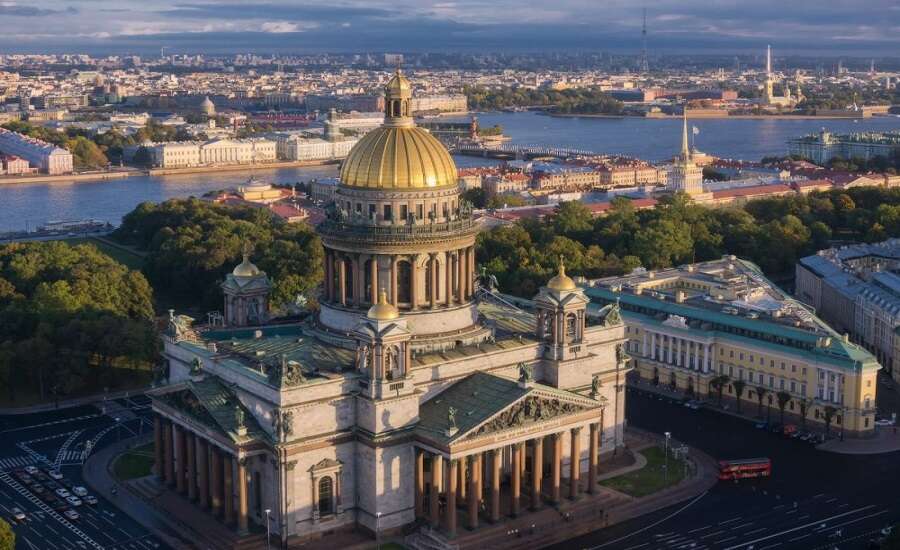
Photo from https://architectureguru.ru/
St Isaac’s Cathedral dates back to 1707, when it was commissioned by Peter the Great. It takes its name from St Isaac of Dalmatia, whose feast day coincided with the Tsar’s birthday (30th May). The cathedral eventually had to be rebuilt four times: the first version was deemed too modest for the growing city; the second was struck by lightning and damaged by floodwater; and the third was deemed too ugly for its harmonious surroundings.
Did you know? Peter the Great and his wife Ekaterina were married in the original church in 1712.
The final version of the cathedral is the structure that we see today, built by Auguste de Montferrand. Montferrand was only 23 when he was granted the honour of constructing St Isaac’s, after submitting 24 separate designs in various architectural styles. He unfortunately died a mere month after the cathedral’s completion.
Did you know? It was said that construction of St Isaac’s Cathedral took so long because a clairvoyant predicted that Montferrand’s untimely death would occur very soon after its completion!
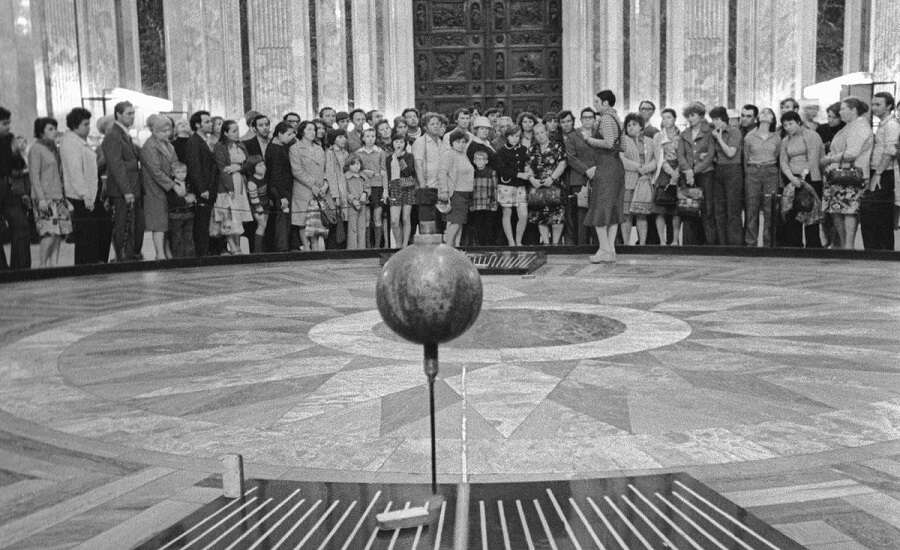
Photo from https://nauka.tass.ru/
Rumour has it that St Isaac’s Cathedral played a part in the downfall of the Romanov family. According to legend, once the scaffolding was removed from the cathedral, the fall of the Romanovs would be imminent. Repairs were finally finished in 1916 - just one year before the Revolution swept through Russia.
After the October Revolution, St Isaac’s Cathedral was looted and the Museum of Atheism was opened inside. But the cathedral was not to fall to ruin and disrepair, and continued holding vital importance in the city. During the Siege of Leningrad, artworks and exhibits from Leningrad’s museums were hidden away in the cathedral’s basement, and a cabbage field was planted on St Isaac’s Square. The gilded dome was also painted grey to confuse the German bombers who used the cathedral as a useful landmark.
Since 1990, services have resumed at St Isaac’s Cathedral on special occasions. It remains open to the public as a museum, although there have been disputes in the last few years over whether the cathedral should be returned to the Russian Orthodox Church.
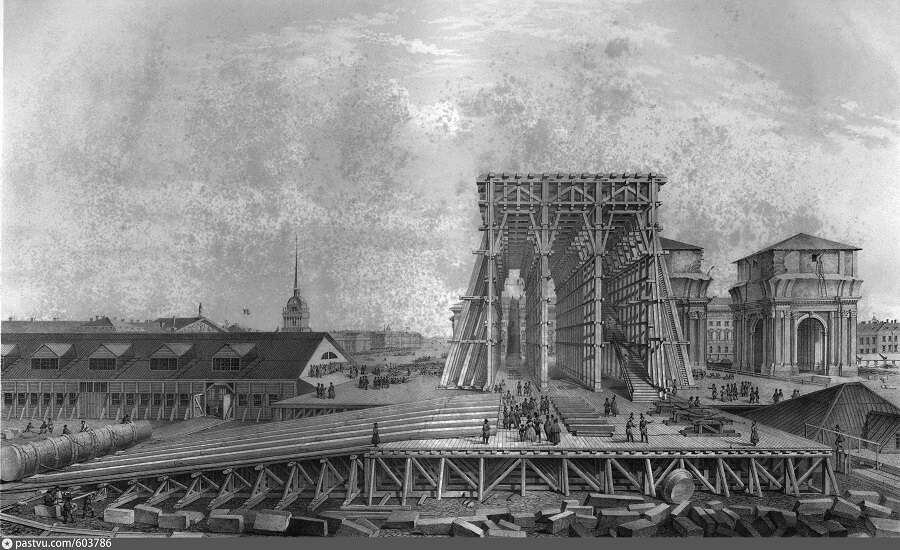
Photo from https://pastvu.com/
St Isaac’s is truly a feat of engineering from top to bottom. 10,000 tree trunks were driven into the marshland to support the foundations of this mighty cathedral, a process which took 125,000 men five years to complete. Marble was quarried from Vyborg, near the present-day Finnish border, to provide the columns propping up the cathedral – 112 monoliths were sailed to St Petersburg on huge barges, rolled up onto the banks of the Neva, and winched upright.
Did you know? Each of the 48 portico columns weigh nearly 120 tons.
Enormous porticos topped with bas-reliefs of religious scenes occupy the four sides of the cathedral, and four smaller domes sit atop each corner. Montferrand took inspiration from the Pantheon and St Paul’s Cathedral in London when he was constructing the central dome of St Isaac’s. He used cutting-edge technology to make the dome light but strong, in turn inspiring the construction of the Capitol building in Washington DC.
Did you know? The dome was covered in 100kg of gold leaf! However, mercury was used in the gilding process, and dozens of craftsmen died as a result.
St Isaac’s wasn’t just a marvel of architecture and engineering but also showcased remarkable artistic craftsmanship. To decorate the interior, Russian and European masters synthesised various artistic mediums, from murals and sculptures to mosaics and stained glass. Some 20 varieties of decorative stone were used, including porphyry, malachite, lapis lazuli, jasper, 14 different types of marble, and hundreds of kilograms of gold.
Did you know? It took over 200 artists, 16 years to decorate the interior of St Isaac’s.
Overall, 23 million roubles were spent to construct St Isaac’s Cathedral. This was 6 times more than the construction costs of the stately Winter Palace.
Did you know? The 40 years of painstaking construction coined a new expression in Finnish - rakentaa kuin Iisakin kirkkoa (literal translation ‘to build like St Isaac’s Church) - denoting something which takes an inordinate amount of time and money to complete.
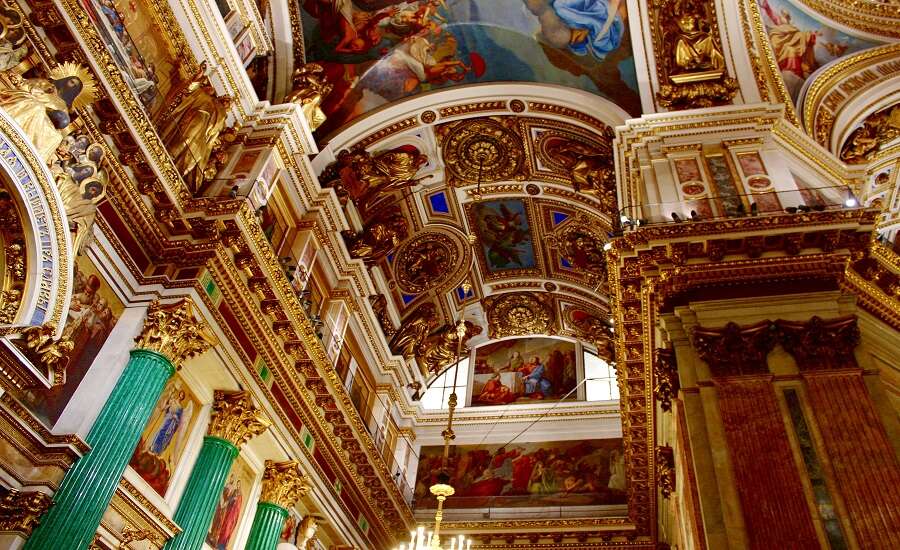
Photo from https://fotoload.ru/
The opulence of St Isaac’s Cathedral interior has been preserved until the present day, and still glistens with gold and precious stones. The sheer size of the cathedral is almost incomprehensible – 12,000 people can fit inside. You will be craning your neck to take in all the artwork adorning the walls, ceiling and dome.
The iconostasis draws your eye as soon as you walk in, a unique combination of painting, mosaic and sculpture framed by malachite and lazulite columns and ornate metalwork. The murals of the cathedral are rare examples of Russian religious artwork from the mid 19th century. The artwork of the dome is gently illuminated by daylight streaming through the windows, and twelve angel statues keep watch below. St Isaac’s stained-glass window is an extremely rare occurrence in Russian Orthodox churches.
Did you know? Many of the cathedral’s paintings deteriorated as a result of St Petersburg’s humid and unforgiving climate. Instead of repainting them, they were replaced with mosaics.
There is a small exhibition with models to illustrate the construction of the various churches built on this spot and displays showing the restoration of the cathedral and the distinctive features of its decor.
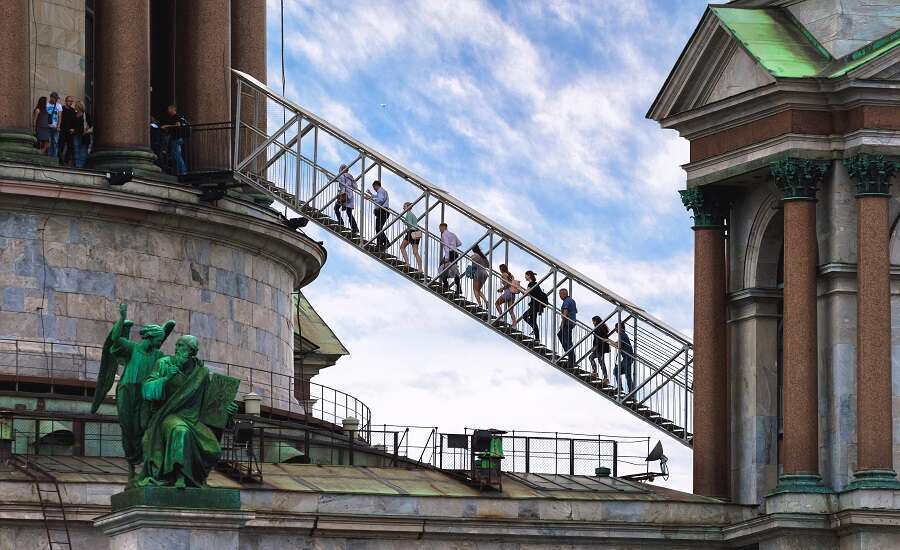
Photo by Арсений Семенов from https://ruscivilization.ru/
For a most magnificent view over St Petersburg, climb the 262 steps to the colonnade of St Isaac’s Cathedral. From a height of 43 metres you will enjoy a panoramic vista reaching all the way to the horizon. Fascinatingly, the view from the cathedral to different parts of the city has remained remarkably unchanged over time due to St Petersburg’s protected skyline.
It’s well worth bringing a pair of binoculars or using those mounted on the colonnade, as some of the city’s most famous landmarks lie in close proximity to St Isaac’s Cathedral. To the west you’ll see the Senate Building, Finnish Gulf and St Petersburg’s docklands. To the north, the River Neva, Admiralty, and the magnificent buildings of University Embankment. To the east lie Palace Square, the Winter Palace, and Peter and Paul Fortress, and to the south is the Mariinsky Palace and St Isaac’s Square.
Address: 4, St. Isaac's Square
Nearest metro: Admiralteyskaya (550m), Sennaya Ploshchad/Spasskaya/Sadovaya (1.1km)
Website: http://cathedral.ru/en
Opening Hours:
Cathedral:
From May 1st till September 30th 10:30 – 22:30. Closed Wednesdays.
From October 1st till April 30th 10:30 - 18:00. Closed Wednesdays.
Colonnade:
From May 1st till September 30th daily 10.00 – 23:30.
From October 1st till April 30th 10:00 – 22:30. Closed on 3rd Wednesday of each month.
Join us on Facebook
We invite you to become a fan of our company on Facebook and read Russian news and travel stories. To become a fan, click here.
Join our own Russian Travel, Culture and Literature Club on Facebook. The club was created to be a place for everyone with an interest in Russia to get to know each other and share experiences, stories, pictures and advice. To join our club, please follow this link.